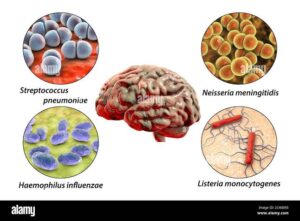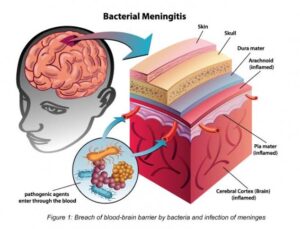Back to: MICROBIOLOGY 300 LEVEL
Welcome to class!
I’m really happy you showed up today! You’re doing something powerful—building knowledge that can help you protect lives. Today, we’re learning about two very important bacteria that cause serious diseases, especially in children and young adults: Neisseria meningitidis and Haemophilus influenzae. These organisms may sound like tough scientific names, but by the end of this class, you’ll understand what they are, what they do, and how to prevent the illnesses they cause—especially in the African setting where outbreaks can be life-threatening.
Neisseria Meningitidis, Haemophilus Influenzae
Neisseria meningitidis
Commonly called the meningococcus, this bacterium is a Gram-negative diplococcus. It is one of the leading causes of bacterial meningitis—an infection of the protective membranes (meninges) surrounding the brain and spinal cord.
Transmission:
It spreads through respiratory droplets from coughing, sneezing, or close contact—such as living in hostels, barracks, or shared dormitories.

Symptoms of Meningitis:
Sudden high fever
Stiff neck
Headache
Nausea and vomiting
Sensitivity to light
Sometimes a rash, confusion, or even seizures in advanced cases
Why It’s Dangerous:
The infection progresses rapidly and can lead to death or brain damage within hours if not treated immediately.
Diagnosis and Treatment:
Confirmed through lumbar puncture and laboratory testing of cerebrospinal fluid. Treated with high-dose intravenous antibiotics like ceftriaxone or penicillin.

Prevention:
Vaccination is key—especially in Nigeria’s “meningitis belt” (northern states like Sokoto, Zamfara, and Kebbi), where outbreaks are common during dry season.
Imagine a secondary school in Sokoto during Harmattan. A student suddenly complains of severe headache and neck stiffness. She’s rushed to hospital and diagnosed with meningococcal meningitis. Her early treatment and vaccination of her classmates prevent a deadly outbreak.
Haemophilus influenzae (Type B)
Often referred to as Hib, this is a Gram-negative coccobacillus. Despite its name, it does not cause influenza. Instead, it can cause meningitis, pneumonia, epiglottitis, sinusitis, and other serious infections, especially in children under five.
Transmission:
Spread through droplets from coughs and sneezes.
Symptoms (depending on the disease):
In meningitis: Fever, irritability, vomiting, poor feeding, and stiff neck
In pneumonia: Cough, fever, difficulty breathing
In epiglottitis: Sore throat, drooling, and difficulty breathing—a medical emergency
Diagnosis and Treatment:
Identified through blood or cerebrospinal fluid tests. Treated with antibiotics such as ceftriaxone or ampicillin.

Prevention:
The Hib vaccine, which is now part of Nigeria’s routine childhood immunisation schedule, is very effective.
Picture a toddler in Lagos who suddenly becomes drowsy, cries uncontrollably, and develops fever. She’s diagnosed with Hib meningitis. Thanks to early medical care and the Hib vaccine, she makes a full recovery.
Summary
- Neisseria meningitidis causes deadly meningitis and spreads rapidly in crowded places.
- Haemophilus influenzae can cause meningitis, pneumonia, and other serious diseases in young children.
- Both are preventable through vaccination, and treatable with antibiotics if detected early.
- Public awareness, early diagnosis, and immunisation programmes are vital in Nigeria and across Africa.
Evaluation
- How does Neisseria meningitidis typically spread among people?
- What are two serious diseases caused by Haemophilus influenzae?
- Why is vaccination important in preventing outbreaks of bacterial meningitis?
Every lesson brings you one step closer to becoming the microbiologist who changes lives. You’re gaining knowledge that could help prevent outbreaks in your community. Keep going strong—you’ve got what it takes! Afrilearn is with you all the way. See you in the next class!
